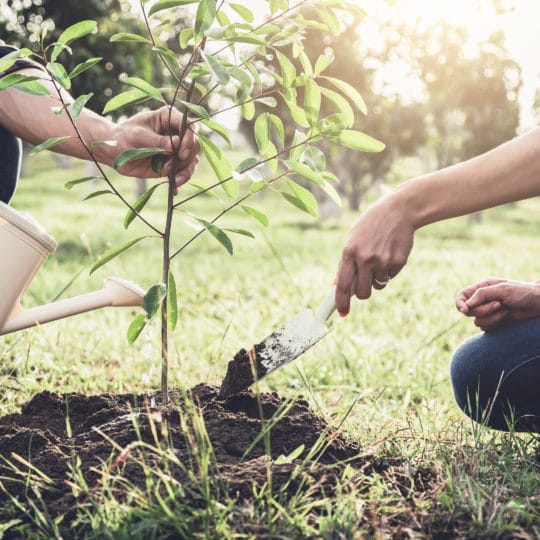Guide for Planting New Trees
From Plant Selection to Planting Process
Posted
March 24, 2022

Congratulations on your decision to plant a new tree! You’re doing a wonderful thing for your yard and the environment. However, there’s more to properly planting new trees than simply digging a hole. It takes planning and regular attention to keep a tree healthy and your yard happy. Follow this helpful guide for planting new trees to make the most of your investment.
Guide for Planting New Trees
Taking care of a tree requires your attention even before you buy any plants. To properly care for a tree, you have to make sure you’re getting one that will thrive in your yard. This means planning before you plant. Here are some things to keep in mind.
- Environment. Certain trees require specific environments to thrive. If you go to your local nursery, they’re likely to sell trees native to your area. Buying trees online means you have to research which trees will grow best in your type of climate and soil.
- Location. When picking the perfect planting spot, you want to make sure the tree will get enough water, air, and light. You also want to make sure you’re not planting it too close to any utility lines above or below ground. Think of how tall your tree will get, and plan to plant it somewhere it won’t eventually become a hazard to any structures in or around your property.
- Maintenance. Some trees require more maintenance than others. While all trees will need regular pruning, you also have to think about if they will produce fruit or leaves that you’ll eventually have to pick or rake.
Once you have a plan, you can purchase your perfect tree and get to planting.
Best Season for Planting New Trees
Technically, you can plant a tree any time of year. However, some seasons are better than others. If you can wait for the dormant season—late fall after leaves drop or early spring before they bud—your new tree has a better chance of getting established before harsh weather sets in.
You also want to make sure the weather conditions are right for planting. Extreme changes in temperatures can shock even the most well-established trees. A new tree is going to be even more vulnerable. Choose a cool day before the snowy season or long spring rains.
If your new tree comes from a container, its roots are more ready to be planted throughout the growing season. If you live in a tropical area without a dormant season, just be sure enough water will be available to help establish newly planted trees.
Transplanting any tree is stressful on the plant, no matter the season. This is why it’s extra important to properly prep the site, carefully handle the roots, and provide follow-up care to help reduce shock and promote recovery.
How to Plant a Tree
Once you’re ready to plant, follow these steps to help ensure your tree quickly establishes its roots in the new location.
- Dig a shallow but broad planting hole. Make the hole as deep as the root ball and two times as wide.
- Remove any wrapping or wire basket from around the root ball and trunk. Carefully straighten any circling roots or remove them.
- Lift the plant by the root ball and place it straight up in the hole. You may want someone else to confirm it’s straight before you add any soil.
- Fill the hole with soil and gently pack it around the base of the root ball to stabilize the plant. Remove any air pockets by firmly packing the soil and periodically adding water.
- Make sure you can still see sections of trunk flare—the area where the trunk expands at the base of the tree.
- If you need to stake the tree for support in windy areas, use three stakes around the trunk or an underground system. Remove once the tree is established after one year of growth.
- Layer about three inches of mulch at the base of the tree without piling it against the trunk. This helps maintain moisture while preventing weeds and decay.
- Keep the soil moist by watering at least once a week in dry conditions and less when it rains. Continue throughout the summer and taper off when the temperature cools again.
- Prune only if branches are damaged during the planting process. Any major pruning should wait until after a full season of growth.
By following the right planting process and providing regular care and maintenance, your tree will not only survive its first growing season but will become well established for years of health.
Professional Tree Planting
Since there’s a lot to consider when choosing the right tree and planting location, it may be best to consult with a professional arborist before beginning the process. Contact Cardinal Lawns with any questions about plant selection and tips. You’ll also want to confirm with your local authorities about the location of underground utility lines before you start digging. Get your new tree off to a healthy start so it not only survives, it thrives.

Download Your FREE Summer Plant Care Guide
Help your plants make it through a hot & dry summer looking like a million bucks with our summer plant watering and maintenance guide!